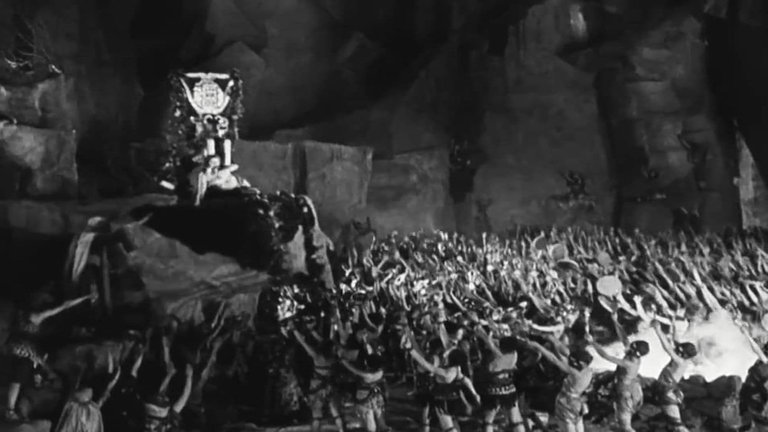Film Review: The Ten Commandments (1923)

Many people today complain that 'woke' Hollywood is shoving its increasingly narrow ideology down the audience's throats instead of trying to tell good stories. All those yearning for good old times when Hollywood was supposedly different in that regard should be reminded that authors' world view always played an important part in creation of film. Actually, a century ago audience was very likely to experience Hollywood films with important messages told even more explicitly than today. A good example is The Ten Commandments, 1923 drama directed by Cecil B. DeMille, known as one of the grandest films of silent era Hollywood.
The film actually begins with the note telling audience that they should adhere to Judeo-Christian traditional values embodied in strict interpretation of biblical Ten Commandments and not to be seduced by modernity, otherwise the world might suffer catastrophe similar to recently ended Great War. This is followed by the Prologue that actually takes around a third of the film's running time and is set in Ancient Egypt during the time of Exodus. The plot shows how Moses (played by Theodore Roberts) leads Israelites from Egyptian captivity, makes the Red Sea part in order to escape chariots sent by pharaoh Rameses the Great (played by Charles De Roche), climbs to Mount Sinai and comes back with God's Ten Commandments just after Israelites have abandoned their God and begun to worship golden calf. The plot then switches to 'The Story' which is set to modern times. It is revealed that the Prologue was the story told by elderly and religious Martha McTavish (played by Edythe Chapman) to her two sons who have very different views about the Bible. While John (played by Richard Dix) is a modest carpenter who tries to live by Ten Commandments, his brother Dan (played by Rod La Roque) is self-confessed atheist who mocks Christianity and claims that he could live well if he breaks all Ten Commandments. Few years later it appears that Dan's immorality has paid off because he has not only prevailed over John while wooing beautiful Mary Leigh (played by Leatrice Joy). Years later, he is not only married to Mary, but also enjoys wealth, influence and a successful career of construction entrepreneur. But Dan's arrogance will be punished through series of accidents and terrible secret kept by his Eurasian mistress Sally Lung (played by Nita Naldi).
The Ten Commandments was made in time when Hollywood was still reeling from the aftermath of scandals like those involving Fatty Arbuckle. DeMille's film represents the attempt to win the hearts and minds of conservative rural America, which still had great sway over country's politics and could have made life of new industry miserable through censorship. For DeMille, who had previously made a series of light-hearted sex comedies in line with hedonistic attitudes associated with Jazz Age, biblical epic represented excellent opportunity to show risqué and salacious content under the excuse of condemning it as sin and depicting it as unacceptable depravity. The Ten Commandments does so in the scenes of Israelites having orgies while worshipping golden calf before God shows them error of their ways. Those scenes are impressive, but not as memorable as the reconstruction of Ancient Egypt that involved thousands of extras, hundreds of chariots and sets that looked as impressive as those David W. Griffith had made for Intolerance few years earlier. This segment also involves special effects that were quite impressive for their age, including those showing the parting of the Red Sea.
Unfortunately, this segment also shows DeMille more as a showman than as an artist. The plot advances too quickly and the acting, including veteran Theodore Roberts as Moses, is too theatrical. Modern-day 'Story' is actually another, quite different and much better film. The segment is more intimate, more realistic and, despite moralising, melodrama and even some problematic suggestions about 'proper' races or miscegenation, much more relatable to modern audiences. DeMille directs film confidently, using real locations of San Francisco, while the acting is very good. As a result, The Ten Commandments is an interesting, well-made and occasionally very entertaining film.
DeMille had barely finished it, due to budget ballooning over the limits set by Paramount Pictures. DeMille in the end had to borrow money from his friend Amadeo Giannini from Bank of America. The risk in the end paid off, with The Ten Commandments becoming huge hit. DeMille used its success to continue making grand biblical epics with which his reputation would later be associated. That included 1956 colour and sound version starring Charlton Heston, which doesn't include the modern setting and is often considered to be one of the greatest Hollywood films of 20th century.
RATING: 6/10 (++)
_
Blog in Croatian https://draxblog.com
Blog in English https://draxreview.wordpress.com/
InLeo blog https://inleo.io/@drax.leo
InLeo: https://inleo.io/signup?referral=drax.leo
Unstoppable Domains: https://unstoppabledomains.com/?ref=3fc23fc42c1b417
Hiveonboard: https://hiveonboard.com?ref=drax y
Bitcoin Lightning HIVE donations: https://v4v.app/v1/lnurlp/qrcode/drax
Rising Star game: https://www.risingstargame.com?referrer=drax
1Inch: https://1inch.exchange/#/r/0x83823d8CCB74F828148258BB4457642124b1328e
BTC donations: 1EWxiMiP6iiG9rger3NuUSd6HByaxQWafG
ETH donations: 0xB305F144323b99e6f8b1d66f5D7DE78B498C32A7
Posted using CineTV